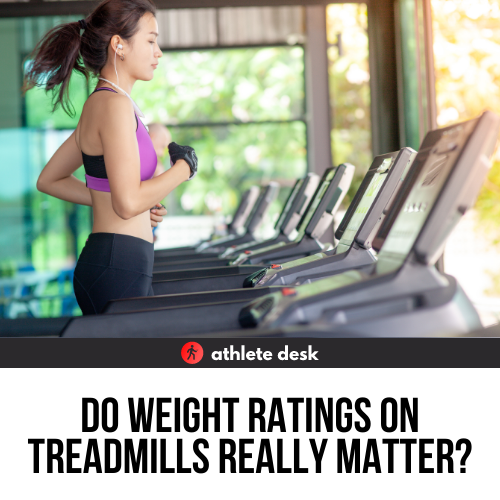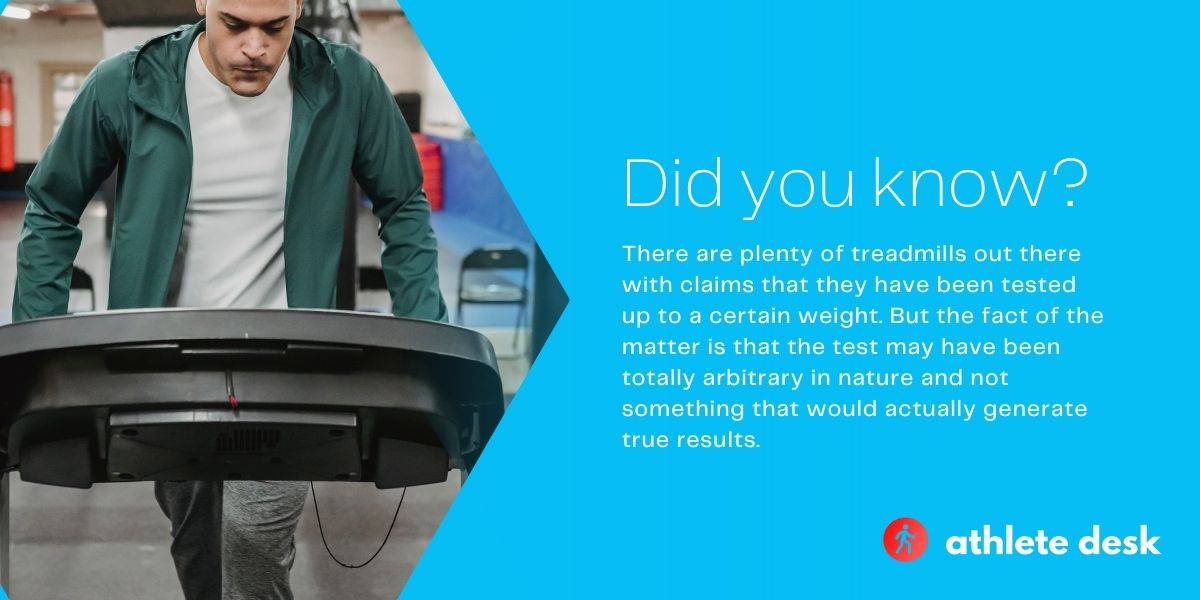Do Weight Ratings on Treadmills Matter?
Treadmills, just as with about any other piece of workout equipment out there, are all rated with weight accordingly.
This means that they are meant to hold only up to that weight and not go over.
But the question becomes whether or not they matter.
For instance, could someone who weighs 300 pounds use a treadmill that is rated for 250 pounds?
They may matter more than you realize but maybe not in quite the way that you expect.

No Industry Standards
The first thing that consumers must realize is that there are not currently any industry standards in place when it comes to determining individual weight ratings for treadmills.
Each of the manufacturers uses its methodology to determine the weight ratings for their treadmills and even that is something of a trade secret.
This isn’t new. For a long time, vehicles were thought to have a “true” miles-per-gallon performance before the EPA stepped in and created government standards.
Since there is no regulatory standard in place for treadmills, the manufacturers are free to claim whatever they want.
There are plenty of treadmills out there with claims that they have been tested up to a certain weight. But the fact of the matter is that the test may have been arbitrary and not something that would generate true results.
With a lack of industry testing to create a standard, there is only one way to know whether or not the weight claims are true and that is through in-depth customer reviews.
Generally speaking, residential treadmills are designed for lower output DC motors, which also means that they are less expensive, too.
Read More >> Top 5 Best Under Desk Treadmills? (2022 Review)
When you operate a treadmill at a lower speed, you are using just a fraction of that DC motor’s power. For standard users, this isn’t a problem.
But with heavier users, it can place immense stress on both the controller and motor, which can cause the entire system to run hot.
Eventually, one or both of the controller and motor would overheat and fail, which means that the workout would come to a very abrupt end.
What Treadmills Weight Ratings Mean
So, what do these ratings mean to the consumer on the whole?
Does a weight rating of 300 pounds mean that it was tested with someone weighing 305 pounds with the unit failing, but didn’t test out if a 300-pound user would work?
No, that isn’t likely. Perhaps it means that the unit failed after several hours of use by that 305-pound individual, but even then, no one knows.
The simple fact is that the manufacturers have considerable knowledge about what will work for the intended application.
But they generally don’t share their common standards as to how those weight ratings come to be.
For most of the treadmills sold in the United States, there is only a UL certification that comes with them, which is meant to address the safety of use.
It does not equate to truth in advertising, which is a whole different thing.
Weight Ratings Are Marketing Fluff
What these ratings for weight equate to is the ability of the manufacturer to position their different models of treadmill towards different types of audience members.
For Example:
Let’s say a manufacturer only has a robust model and one that is not so robust.
They may give the former a 350-pound rating while the other gets a 250-pound rating.
They want to position the robust one as the “premium” version and the less robust one as the “economy” model.
In reality, there are more than a few factors that go into creating these weight ratings. Lower-end treadmills are generally going to specify a weight rating in the 200- to 300-pound range.
The higher-end models, meanwhile, tend to have weight limits between 300 and 500 pounds.
Finally, some ultra-premium manufacturers claim to have weight limits of up to 800 pounds on some of their treadmills.
What You Should Be Looking For?
Treadmill Deck Thickness:
One major indicator of the weight-bearing capacity is the overall thickness of the treadmill’s deck.
The deck lamination begins to wear, which can lead to higher friction. Eventually, the deck may need to be replaced if it can’t be flipped over for a second time, such as with double-side laminated decks.
A deck that is roughly ¾” will be more likely to have its lamination degraded from regular heavy pounding than something that costs a bit more upfront but has a thicker, heavier 1” deck.
Horsepower Rating:
There is another factor worth considering as well and that is the horsepower rating.
That said, be aware that horsepower on its own isn’t a meaningful indicator of the treadmill’s ability to handle heavier users.
There are a couple of factors that matter as well as horsepower:
There is the gear-down ratio of the drive belt.
The diameter and weight of the flywheel:
which moderates how quickly speeds can change when you step down on the belt surface with each step and the friction coefficient of the belt against the deck, and the roll diameters.
Torque:
Perhaps the most meaningful indicator is torque.
This is the ability of the motor to overcome the friction created between the deck and belt and specific RPMs.
In layperson’s terms, these are the speeds and inclines that a treadmill would offer to its users.
Read More >> Why is My Treadmill Squeaking?
Incline:
Incline can provide an interesting variable. Even a modest incline can reduce the motor’s load substantially.
That said, working out while walking at an incline is not something that is highly recommended, so keep that in mind.
Let’s Get Technical:
Torque, though it is important, is not something that can be quoted in terms of single figures from any spec book.
For a motor, the torque rating can be measured using a dynamometer and it can change the RPM range of a motor. So, typically speaking, it is normally expressed in graph form.
You can also get a pretty rough idea of the torque capacity on a treadmill by looking at the maximum RPM of the motor as well as the horsepower rating.
Horsepower is a function of both RPM and torque, meaning that horsepower output will be lower at lower RPMs.
What does all that mean?
Well, when you need the most horsepower, the motor will be running at lower RPMs and might not be able to bring enough torque to keep the belt moving along smoothly.
A low-torque motor that runs at higher RPM may have the same performance as a high-torque motor that runs at lower RPMs.
Most manufacturers don’t publish what their motors are doing in terms of torque, but some DC motor manufacturers will state what is known as a torque constant or “torque/amps.”
The more amps that are provided to the motor, the higher the level of torque is accordingly.
Limits of motors and controllers:
That is where the natural limits of the controller and motor come into question.
Limit of motor:
The limit of the motor to produce higher levels of torque all depends on how many amps it takes, which is a natural function of the design.
Limit of the controller:
The controller, on the other hand, works to vary the amps that get delivered to the motor. They also limit the upper end to keep the motor from overheating.
Most of the time, this works, until the unit has been tasked with delivering too much power for too long a period, which can cause either the controller or the motor to fry.
Read More >> How to Lubricate a Treadmill?
For the most part, treadmill manufacturers choose motors that have the highest torque ratings at RPMs that are generated at the most frequently used speed settings that they expect most customers to use.
Standard exercise treadmills generally have this setting at running speed, not walking speed. Torque, in practice, is more of a function of the design of the motor than a separate, selectable feature.
When all things are considered, the design is constrained by RPM and horsepower to meet target costs.

Why Walking Is Actually Harder on Treadmill Motors Than Running
Though it may sound like a made-up fact, it is true.
At walking speeds, the motor has the task of hauling your body against the friction on the belt down onto the deck caused by your full weight.
When you run, though, you are essentially kicking the belt backward while lifting yourself into the air.
For this reason, even the most expensive running treadmills can die in a short period when used for walking purposes.
Whether you are intending to work out by walking or want to make a workstation out of your treadmill, make sure to find a treadmill that was meant for walking.
The motor would have been picked to handle walking loads, and the weight rating would have been chosen under a regimen of walking as well.
The best treadmills for walking are the ones that were originally designed for use in rehabilitation clinics.
Most of these top out at around 4.0 mph, partially because they have been limited through software changes.
They won’t have the torque needed for hours and hours of continuous use at just 1 to 2 mph, so beware of burnout after a few weeks to a few months of use.
Since most treadmill manufacturers don’t post their performance specs, which would allow consumers to compare in a more apples-to-apples way, skew towards the treadmills that have the best warranty options.
You never know how your type of workout could impact the motor, leading to burnout in months instead of the advertised period.
When a manufacturer offers a longer warranty, it is a general indication as to just how confident they are in their product.
Daily Use Motor Performance
To keep it as simple as possible, weight ratings are kind of arbitrary because we aren’t privy to all of the testing information possessed by the manufacturers.
A motor that is underpowered is more likely to fail than something that is properly-suited for the activity in question.
For daily users, you will notice a difference in underpowered motors sooner rather than later. It is worth noting that even if a treadmill is rated for 300 pounds, a 300-pound user will wear down the motor far more quickly than a 200-pound user.
The most common reason that motors fail is due to short circuits in the coil windings.
It is believed that the shaft fractures are the most common failure issue, but that isn’t true (though it can still happen).
The short circuits come from a wire insulation failure as the result of too many hours of continuous high load use (which makes all of the components a lot hotter).
If the motor doesn’t fail, then it is likely that the control board will.
This is because the control board will have to deliver a lot more power to the motor at loads that are far more strenuous.
Read More >> Standing Desk vs. Treadmill Desk (Which is Better?)
Over time, it can blow the capacitor or another component before either the controller or the motor goes.
When it comes to replacing them, the controller is no cheaper than a whole new motor and no easier to deal with either.
The Final Word
The simple fact of the matter is that you generally can’t compare weight ratings between two manufacturers because the numbers aren’t comparable.
You can use weight ratings between two units that come from the same manufacturer because they are using relative power standards.
Any continuous load will cause stress on the motor, controller, and other components.
So, if you plan to be walking for hours at a time, consider the stress that it will place on the components of the treadmill.
So even if you fall under the weight rating, being at the higher end of that rating can wear down the treadmill components a lot more quickly.
Until there are standards put in place for weight ratings on treadmills, it will be an exercise in review reading.
Only from those readings can you gain a more accurate representation of the limitations involved.








